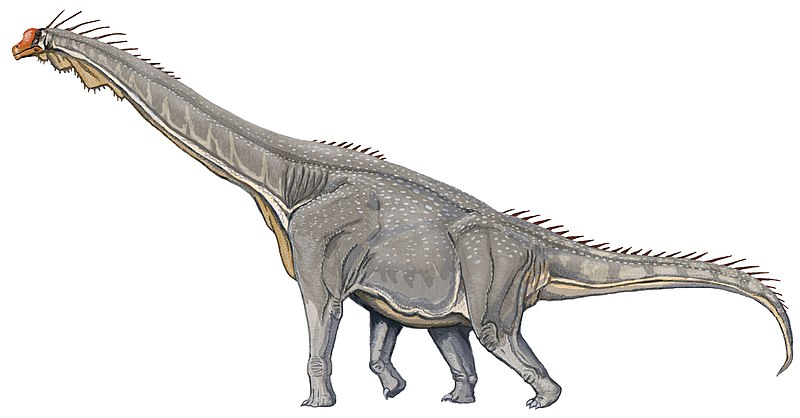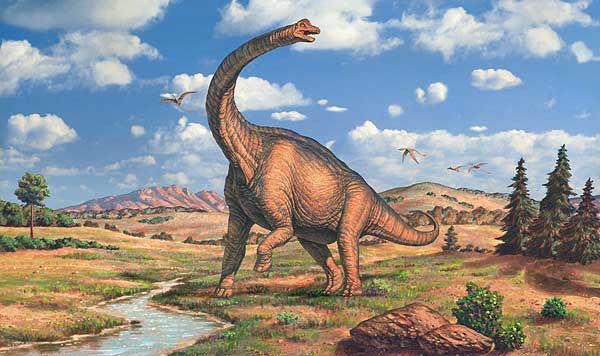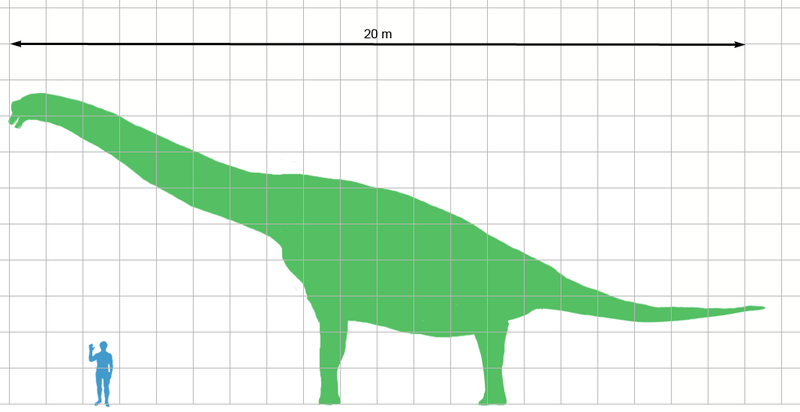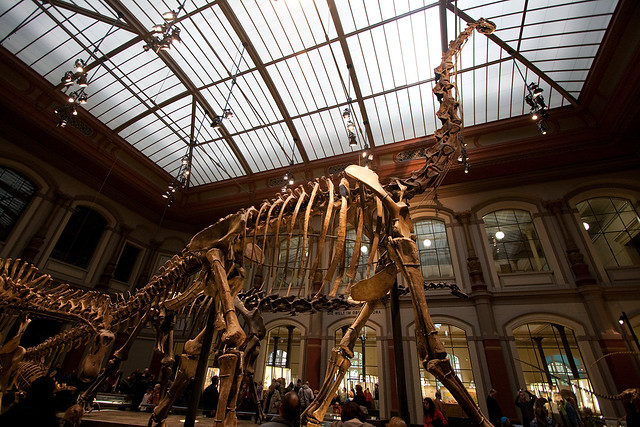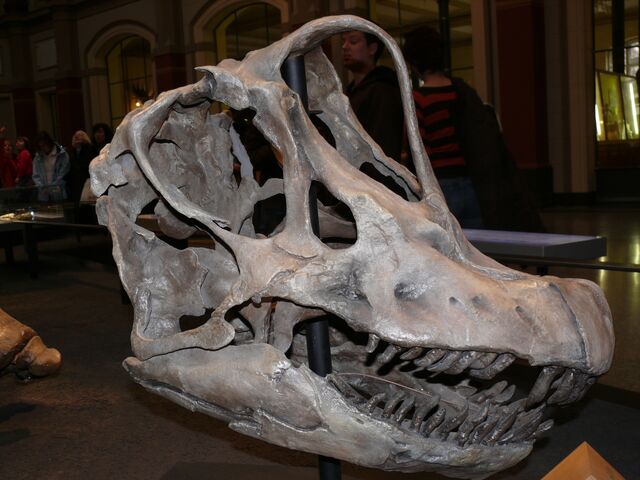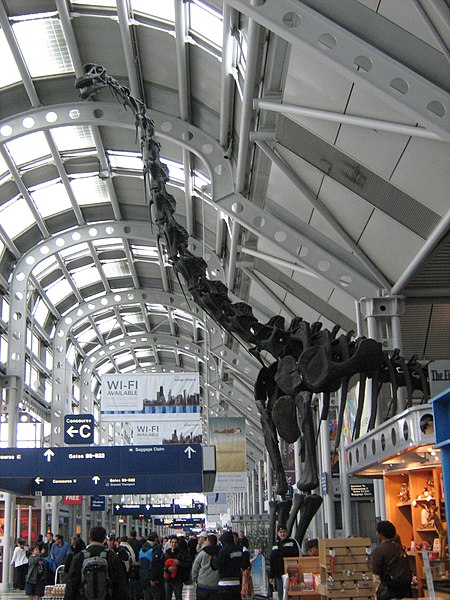[Recent Entries][Archive][Friends][User Info]
| August 1st, 2012 | |
|---|---|
| 01:11 pm [industrialterro] [Link] |
Brachiosaurus Брахиоза́вр (Brachiosaurus; буквально «плечистый ящер») — вымерший род растительноядных динозавров из группы зауроподов-макронарий, живших в конце юрского периода (около 161,2 — 145,5 млн лет назад) на территории нынешней Северной Америки и Африки. До открытия сейсмозавра, считался самым высоким динозавром. Маленькая голова на конце восьмиметровой шеи находилась на высоте 13 метров. Ноздри брахиозавра находились на своеобразном полукруглом костном гребне выше глаз. Вероятно, ноздри соединялись с воздушными мешками, как у некоторых утконосых динозавров. Также это может объяснятся тем, что у ящера, возможно, был короткий хобот. Передние ноги брахиозавра существенно длиннее задних, по внешнему виду ящер напоминал гигантского жирафа. Однако его шея была направлена не вверх, а вперед под углом примерно 45 градусов. Зубы мощные, ложковидные. Вероятно, ящеры питались листвой деревьев. Брахиозавры жили на территории Северной Америки и Африки (Танзания) в конце юрской эпохи, но сходные с ними ящеры (например, завропосейдон) дожили до середины мелового периода в Северной Америке и достигли даже более крупных размеров, чем брахиозавры. Американский брахиозавр (B. altitorax Riggs, 1903) — один из самых крупных зауропод, длиной до 27 метров и весом около 50 тонн. В Берлинском музее имени Гумбольдта выставлен скелет 14-метрового Brachiosaurus brancai (найденый германской Восточно-Африканской палеонтологической экспедицией на горе Тендагуру в Танзании), который теперь относится к отдельному роду жираффатитан. Brachiosaurus nougaredi был выделен Lapparent в 1960 году определен как новый вид брахиозавра, описаный по части крестца и передней конечности, найденых в местности Wargla в Алжире. Позже было установлено, что данные окаменелости относятся к альбскому веку, и примерно на 40 миллионов лет моложе Brachiosaurus altithorax и Giraffatitan. В настоящее время таксон помечен как nomen dubium, вероятно, из-за низкого качества ископаемого материала. В 2003 году Герхардом Майером (Gerhard Maier) в Indiana Univeristy Press был описан новый род Abdallahsaurus, который в настоящее время помечен как nomen nudum, а его останки относя к Giraffatitan. Like all sauropod dinosaurs, Brachiosaurus was a quadrupedal animal with a small skull, a long neck, a large trunk with a high-ellipsoid cross section, a long, muscular tail and slender, columnar limbs. The skull had a robust, wide muzzle and thick jaw bones, with spoon–shaped teeth. As in Giraffatitan, there was an arch of bone over the snout and in front of the eyes that encircled the nasal opening, although this arch was not as large as in its relative. Large air sacs connected to the lung system were present in the neck and trunk, invading the vertebrae and ribs, greatly reducing the overall density. Unusually for a sauropod, the forelimbs were longer than the hind limbs. The humerus (upper arm bone) of Brachiosaurus was relatively lightly built for its size, measuring 2.04 metres (6.7 ft) in length in the type specimen. The femur (thigh bone) of the type specimen was only 2.03 metres (6.7 ft) long. Unlike other sauropods, Brachiosaurus appears to have been slightly sprawled at the shoulder joint, and the ribcage was unusually deep. This led to the trunk being inclined, with the front much higher than the hips, and the neck exiting the trunk at a steep angle. Overall, this shape resembles a giraffe more than any other living animal. Because "Brachiosaurus" brancai (Giraffatitan) is known from much more complete material than B. altithorax, most size estimates for Brachiosaurus are actually for the African form. There is an additional element of uncertainty for North American Brachiosaurus because the most complete skeleton appears to have come from a subadult. Over the years, the mass of B. altithorax has been estimated as 35.0 metric tons (38.6 short tons), 43.9 metric tons (48.4 short tons), and, most recently, 28.7 metric tons (31.6 short tons). In the first and last cases, the authors also provided estimates for Giraffatitan, and found that genus to be somewhat lighter (31.5 metric tons (34.7 short tons) for Paul [1988] and 23.3 metric tons (25.7 short tons) for Taylor [2009]). The length of Brachiosaurus has been estimated at 26 metres (85 ft). With the removal of the East African Giraffatitan, Brachiosaurus is known only from the Morrison Formation of western North America. The Morrison Formation is interpreted as a semiarid environment with distinct wet and dry seasons, and flat floodplains. Vegetation varied from gallery forests (river–lining forests in otherwise treeless settings) of conifers, tree ferns, and ferns, to fern savannas with rare Araucaria-like trees. Several other sauropod genera were present in the Morrison Formation, with differing body proportions and feeding adaptations. Among these were Apatosaurus, Barosaurus, Camarasaurus, Diplodocus, Haplocanthosaurus, and Supersaurus. Brachiosaurus was one of the less abundant Morrison Formation sauropods. In a survey of over 200 fossil localities, John Foster reported 12 specimens of the genus, comparable to Barosaurus (13) and Haplocanthosaurus (12), but far fewer than Apatosaurus (112), Camarasaurus (179), and Diplodocus (98). Brachiosaurus fossils are found only in the lower-middle part of the expansive Morrison Formation (stratigraphic zones 2-4), dated to about 154-153 million years ago, unlike many other types of sauropod which have been found throughout the formation. In contrast to most other sauropods, brachiosaurids had an inclined back, due to their long forelimbs. Therefore, if the neck exited the body in a straight line, it already pointed upwards. The exact angle is influenced by how the pectoral girdle is reconstructed, that is how the shoulder blades are placed on the ribcage. The mobility of the neck was reconstructed as quite low by Stevens and Parrish, while other researchers like Paul and Christian and Dzemski argued for more flexible necks. Brachiosaurus is thought to have been a high browser, feeding on foliage well above the ground. Even if it did not hold its neck near vertical, and instead had a straighter neck, its head height may still have been over 9 metres (30 ft) above the ground. It probably fed mostly on foliage above 5 metres (16 ft). This does not preclude the possibility that it also fed lower at times, between 3 to 5 metres (9.8 to 16 ft) up. Its diet likely consisted of ginkgoes, conifers, tree ferns, and large cycads, with intake estimated at 200 to 400 kilograms (440 to 880 lb) of plant matter daily. However, more recent studies estimate that ~240 kilograms (530 lb) of plant matter would have been sufficient to feed a 70 metric tons (77 short tons) sauropod, so Brachiosaurus may have required only about 120 kilograms (260 lb) of fodder a day. Brachiosaur feeding involved simple up–and–down jaw motion. The teeth were arranged to shear material as they closed, and were probably used to crop and/or nip vegetation. It has repeatedly been suggested, e.g. in the movie Jurassic Park, that Brachiosaurus could rear into a bipedal or tripodal (with tail support) pose to feed. However, a detailed physical modelling-based analysis of sauropod rearing capabilities by Heinrich Mallison showed that while many sauropods could rear, the unusual brachiosaurid body shape and limb length ratio made them exceptionally ill suited for rearing. The forward position of the center of mass would have led to problems with stability, and required unreasonably large forces in the hips to obtain an upright posture. Brachiosaurus would also have gained relatively little from rearing (only 33% more feeding height), compared to other sauropods, for which a bipedal pose may have tripled the feeding height. Like all sauropods, Brachiosaurus was homeothermic (maintaining a stable internal temperature) and endothermic (controlling body temperature through internal means), meaning that it was able to actively control its body temperature, producing the necessary heat through a high basic metabolic rate of its cells. In the past, Brachiosaurus has been used an example of a dinosaur for which endothermy is unlikely, because of the combination of great size (leading to overheating) and great caloric needs to fuel endothermy. However, these calculations were based on incorrect assumptions about the available cooling surfaces (the large air sacs were not known), and a grossly inflated body mass. These inaccuracies resulted in overestimation of heat production and underestimation of heat loss. The large nasal arch has been postulated as an adaptation for cooling the brain, as a surface for evaporative cooling of the blood. Again, when this was proposed, cooling via the air sacs was not known, and thus not taken into account. Furthermore, other similar sized sauropods had no comparable structure. Additionally, in proportion to the entire animal, the nasal arch is very small, and would thus have made only an insignificant contribution to heat loss. Голова брахиозавра по сравнению с телом была очень мала и распологалась на длинной и мускулистой шее. Череп брахиозавра слегка вытянут и вооружен множеством крепких ложковидных зубов. Зубы идеально подходили для обрывания листвы с верхушек деревьев. Большая, изогнутая кость над глазницами динозавра указывает на то, что ноздри находились над глазами. Вероятно, ноздри брахиозавра, соединялись с воздушными мешками, как у некоторых утконосых динозавров. Брахиозавр перемещался на четырех огромных колонообразных ногах. Свое зазвание брахиозавр получил за очень длинные передние конечности. Брахиозавриды единственные динозавры, у которых передние конечности были длиннее задних. Грудь и плечи находились на высоте 2,5 - 3 метра над землёй. Ноги брахиозавра распологались вертикально под туловищем (как у слонов). Благодаря такой конструкции тазовых костей динозавру было легче выдерживать вес тела. Пальцы на ногах брахиозавра были короткими и толстыми. На ступнях имелись подушки-амортизаторы: они смягчали удары при ходьбе, защищая кости ног от давления огромной массы тела. Брахиозавр мог дотянуться до самых высоких ветвей, которые были вне досягаемости для других растительноядных динозавров. Его шея состояла из 12 позвонков длиной по 70 см каждый. В результате шея достигала длины 9 метров. Благодаря длинной шее, брахиозавр добывал себе пропитание примерно так же как это делают современные жирафы. Отличительной особенностью всех зауроподов было строение их позвоночника. Позвоночник брахиозавра имел боковые отверстия. Эти отверстия были заполнены воздухом, что облегчало вес позвоночника, но при этом оставляло его достаточно прочным, для того чтобы выдерживать огромный вес брахиозавра. Кровоснабжение - очень важный момент для динозавра такого роста как брахиозавр. При поднятой шее сердцу очень трудно было доставлять кровь к голове, чтобы питать мозг. Недостаточное кровоснабжение могло вызвать вялость у динозавра или даже потерю сознания. Сердце должно было поддерживать определенное кровяное давление, чтобы питать мозг. Но проблема возникала, когда брахиозавр наклонялся - перепады давления могли привести к разрыву кровеносных сосудов головы. Чтобы этого не происходило, сердце должно было снижать давление, при этом специальные клапаны, расположенные в кровеносных сосудах шеи, не позволяли крови вернуться к сердцу прежде чем она достигнет мозга. Некоторые ученые предпологают, что брахиозавр имел не одно сердце, чтобы перегонять кровь по такому огромному телу. Чтобы получать энергию, необходимую для роста и движения, брахиозавр должен был поглощать невероятное количество пищи. Брахиозавру в день требовалось до 1500 кг пищи - это в 10 раз больше чем нужно современному слону. Предполагается, что брахиозавры вели стадный образ жизни. Численность стада была, в среднем, до 20 особей. Палеонтологи делают такой вывод, исходя из множества окаменелых следов брахиозавров, найденных в одном месте. Брахиозавриды (Brachiosauridae) — семейство ящеротазовых динозавров инфраотряда зауроподов, живших около 161 - 100 млн лет назад. Представляли собой травоядных четвероногих животных с большими передними (больше чем задние) конечностями, длинными шеями и хвостами. Несмотря на их характерные отличительные особенности, существуют некоторые споры относительно того, действительно ли брахиозавриды являются отдельным семейством или же они относятся к титанозавроформам. В результате, есть также некоторые споры о том, какие животные принадлежат к этому семейству. Сейчас реконструируется скелет крупнейшего в мире брахиозаврида - жираффатитана (ранее — брахиозавр бранкаи) в музее имени Гумбольдта в Берлине, Германия.
Репродукции (1, 2, 3, 4, 5, 6, 7, 8, 9, 10, 11, 12, 13, 14):
Размеры тела в сравнении с человеком:
Ископаемые останки (1, 2, 3, 4, 5, 6, 7, 8):
Tags: Вымершие рептилии, Юра, авеметатарзалии, архозавроморфы, архозавры, брахиозавриды, диапсиды, динозавроморфы, динозавры, завроподоморфы, завроподы, макронары, титанозавроформы, ящеротазовые |
